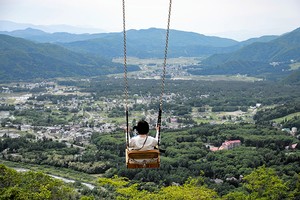THE ASAHI SHIMBUN
October 3, 2024 at 18:09 JST
MIYAZAKI—Dangerous reminders of Miyazaki Airport's past as a former Imperial Japanese Navy air base during World War II continue to resurface in the unexploded ordnance that remains beneath the surface.
The latest incident occurred on Oct. 2 when an undetonated wartime bomb believed to have been dropped by U.S. forces went off suddenly beneath an airport taxiway and created a large crater.
In June 2021, an unexploded U.S.-made bomb, estimated to weigh one ton, was discovered during asphalt resurfacing work at the airport’s parking apron.
In June 2011, a worker conducting pipework in the green area next to the runway found an undetonated U.S.-made 50-kilogram bomb.
In November that year, another unexploded U.S.-made bomb, weighing 250 kg, was discovered underground beside the runway during the installation of runway lights.
Although these bombs were safely removed by the Self-Defense Forces, the runway was closed for up to four hours.
In January 2009, an unexploded ordnance was also found in a residential area near the airport.
According to the transport ministry’s airport technology division, magnetic inspections are conducted during the construction of runways and taxiways if the site has a history of bombings or if unexploded ordnance was found during previous work.
Miyazaki Airport, which was bombed during the war, was subject to such inspections.
The inspections involve two types of surveys: a horizontal survey, which examines depths of up to two meters; and a vertical survey, which probes deeper areas within a one-meter radius.
During post-war construction, a 250-kg undetonated bomb was discovered at the airport. Inspections were carried out to the required depth, based on the bomb’s weight and ground conditions, according to the transport ministry.
The unexploded bombs discovered in 2011 and 2021 were detected through magnetic inspections conducted during maintenance work.
Even though unexploded bombs were found after construction, no further detailed inspections were conducted, as it was assumed that the initial magnetic survey during construction had ensured safety, the division said.
Unexploded ordnance poses a risk of detonation if impacted and could also explode spontaneously.
In the latest incident, a 59-year-old employee working at a sewage treatment facility near the airport said he heard a loud “boom” around 8 a.m. on Oct. 2 while he was preparing for work.
“I thought something had hit the glass,” he said. “I didn’t think it came from the airport.”
He added that it could have been disastrous if the explosion had occurred on the taxiway while a plane was passing nearby.
“I want the cause to be investigated,” he said.
The damaged taxiway forced the runway to be closed from the morning with a total of 87 flights canceled. According to the transport ministry's Miyazaki airport office, repair work was completed on the crater on the evening of Oct. 2.
An association specializing in detecting unexploded ordnance said that three cases of spontaneous unexploded bomb detonations had been confirmed in Miyazaki Prefecture by 1975.
Nationwide, there have been around 20 such incidents reported since the end of the war.
Sotaro Tsuboi, a professor in the regional economics department at Teikyo University who is well-versed in unexploded ordnance, said, “When I saw the news, I thought it was highly likely to be an undetonated bomb, but I was surprised it exploded inside the airport.”
Tsuboi said that around 1,500 to 2,000 unexploded bombs are discovered nationwide each year, and although the numbers are gradually decreasing, many remain.
“Areas that were bombed during the war are particularly likely to have unexploded ordnance,” he said. “We need to establish a system to provide public funding for surveys aimed at detecting these bombs in advance.”
Miyazaki Airport’s predecessor, Akae airfield, was built by the Imperial Japanese Navy in 1943 and was targeted for bombing runs during World War II.
The airport later opened in 1954 as a training airfield for the Civil Aviation College.
The same year, Far East Airlines, now All Nippon Airways Co. (ANA), began operating three weekly flights on the Osaka-Fukuoka-Miyazaki route.
(This article was written by Junya Sakamoto, Erika Matsumoto and Yuji Masuyama.)




















A peek through the music industry’s curtain at the producers who harnessed social media to help their idols go global.
A series based on diplomatic documents declassified by Japan’s Foreign Ministry
Here is a collection of first-hand accounts by “hibakusha” atomic bomb survivors.
Cooking experts, chefs and others involved in the field of food introduce their special recipes intertwined with their paths in life.
A series about Japanese-Americans and their memories of World War II